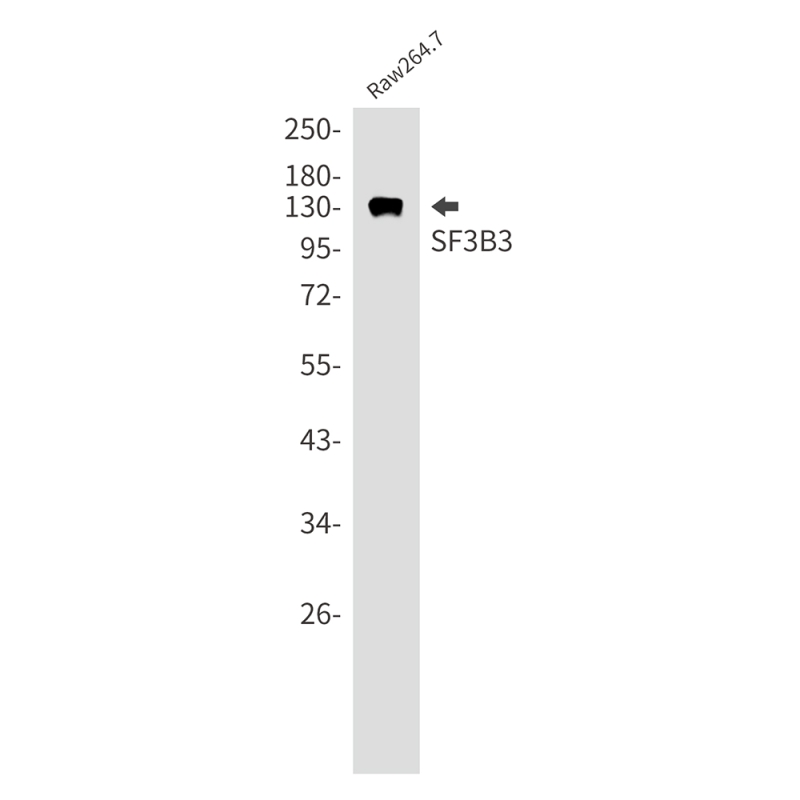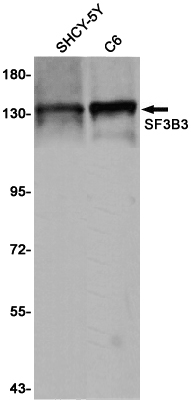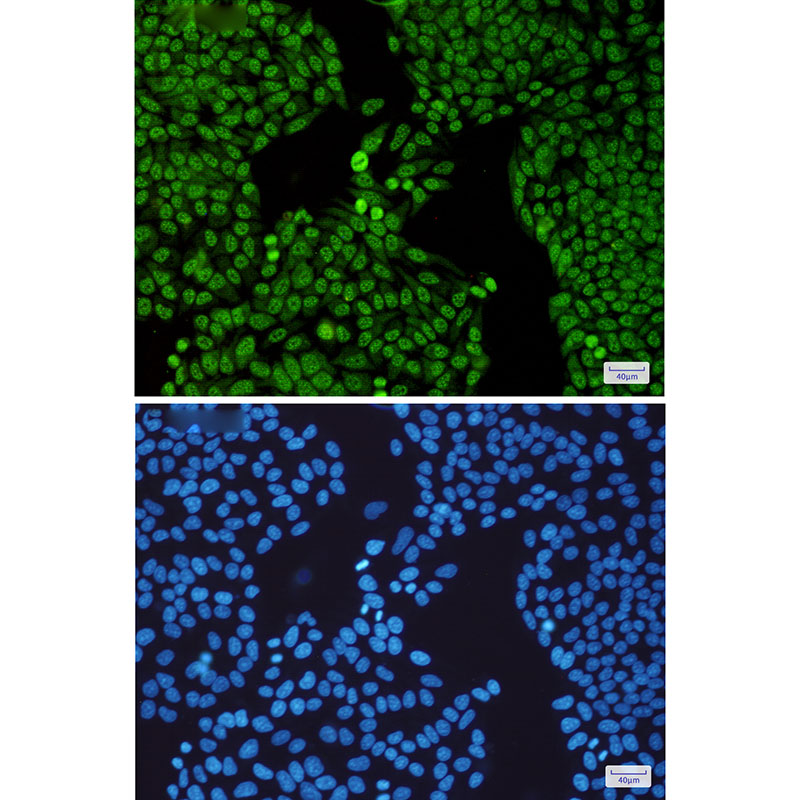


| WB | 1/500-1/1000 | Human,Mouse,Rat |
| IF | 咨询技术 | Human,Mouse,Rat |
| IHC | 咨询技术 | Human,Mouse,Rat |
| ICC | 1/50-1/200 | Human,Mouse,Rat |
| FCM | 咨询技术 | Human,Mouse,Rat |
| Elisa | 咨询技术 | Human,Mouse,Rat |
| Aliases | SF3B3; KIAA0017; SAP130; Splicing factor 3B subunit 3; Pre-mRNA-splicing factor SF3b 130 kDa subunit; SF3b130; STAF130; Spliceosome-associated protein 130; SAP 130 |
| Entrez GeneID | 23450 |
| WB Predicted band size | Calculated MW: 136 kDa; Observed MW: 136 kDa |
| Host/Isotype | Rabbit IgG |
| Antibody Type | Primary antibody |
| Storage | Store at 4°C short term. Aliquot and store at -20°C long term. Avoid freeze/thaw cycles. |
| Species Reactivity | Human,Mouse,Rat |
| Immunogen | A synthetic peptide of human SF3B3 |
| Formulation | Purified antibody in TBS with 0.05% sodium azide,0.05%BSA and 50% glycerol. |
+ +
以下是关于SF3B3抗体的3篇参考文献概览,供参考:
---
1. **文献名称**:*Structural insights into the role of SF3B3 in spliceosome assembly*
**作者**:Zhang et al.
**摘要**:通过冷冻电镜技术解析了SF3B3在剪接体复合体中的结构,并利用SF3B3抗体验证其在RNA剪接中的功能。研究表明SF3B3与其他剪接因子相互作用,对维持剪接体稳定性至关重要。
---
2. **文献名称**:*SF3B3 overexpression promotes colorectal cancer progression via aberrant splicing*
**作者**:Wang et al.
**摘要**:研究发现SF3B3在结直肠癌中高表达,通过Western blot和免疫组化(使用SF3B3抗体)证实其与肿瘤侵袭性的关联。异常剪接导致致癌基因激活,提示SF3B3作为潜在治疗靶点。
---
3. **文献名称**:*A functional screen identifies resistance to splicing inhibition in SF3B3-mutant cancers*
**作者**:Darman et al.
**摘要**:探讨SF3B3突变对剪接抑制剂敏感性的影响,使用SF3B3抗体进行蛋白水平验证。发现特定突变导致剪接异常,并赋予肿瘤细胞耐药性,为精准治疗提供依据。
---
4. **文献名称**:*SF3B3 interacts with NOTCH1 to regulate oncogenic splicing in leukemia*
**作者**:Yoshida et al.
**摘要**:揭示SF3B3与NOTCH1的相互作用通过免疫共沉淀(依赖SF3B3抗体)和RNA测序。结果表明,该互作驱动白血病中异常剪接事件,影响疾病进展。
---
以上文献均涉及SF3B3抗体的实验应用(如蛋白检测、互作验证等),涵盖结构、癌症机制及治疗研究领域。如需具体文献,建议通过PubMed或期刊数据库进一步检索。
The SF3B3 antibody targets the splicing factor 3B subunit 3 (SF3B3), a core component of the SF3B complex within the U2 small nuclear ribonucleoprotein (snRNP) of the spliceosome. SF3B3 plays a critical role in pre-mRNA splicing by recognizing branch site sequences and facilitating spliceosome assembly. Dysregulation of SF3B3 has been linked to splicing errors associated with cancers, neurodegenerative diseases, and developmental disorders.
SF3B3 antibodies are widely used in research to investigate spliceosome dynamics, protein interactions, and SF3B3's functional roles. These antibodies are typically developed in hosts like rabbits or mice, validated for applications such as Western blotting, immunoprecipitation, and immunofluorescence. Specificity is confirmed using knockdown controls or SF3B3-deficient cell lines.
In disease contexts, SF3B3 antibodies help detect aberrant splicing patterns or mutations (e.g., in cancers like leukemia), providing insights into molecular mechanisms and therapeutic targets. Commercial antibodies often include reactivity data for human, mouse, and rat samples. Researchers rely on these tools to explore SF3B3's involvement in cell cycle regulation, stress responses, and its potential as a biomarker, underscoring its importance in both basic and translational studies.
×